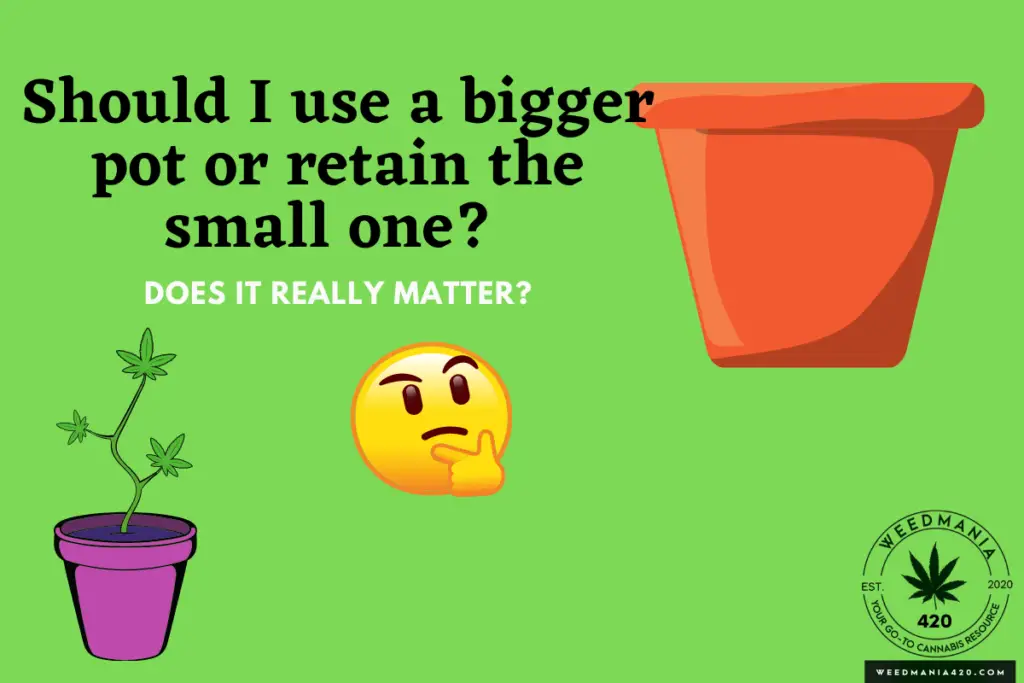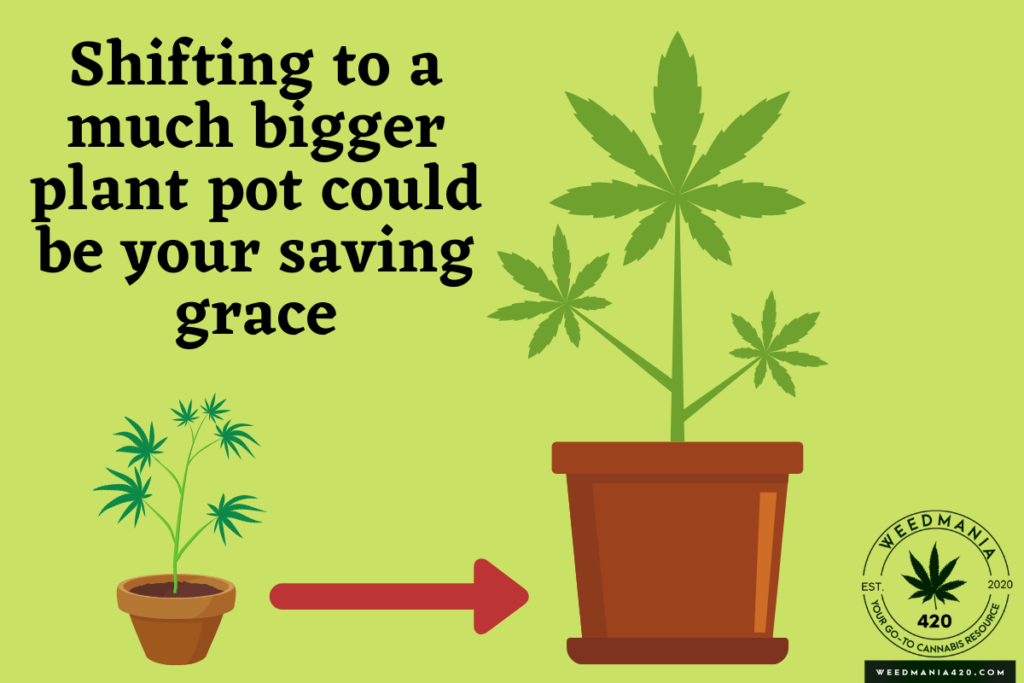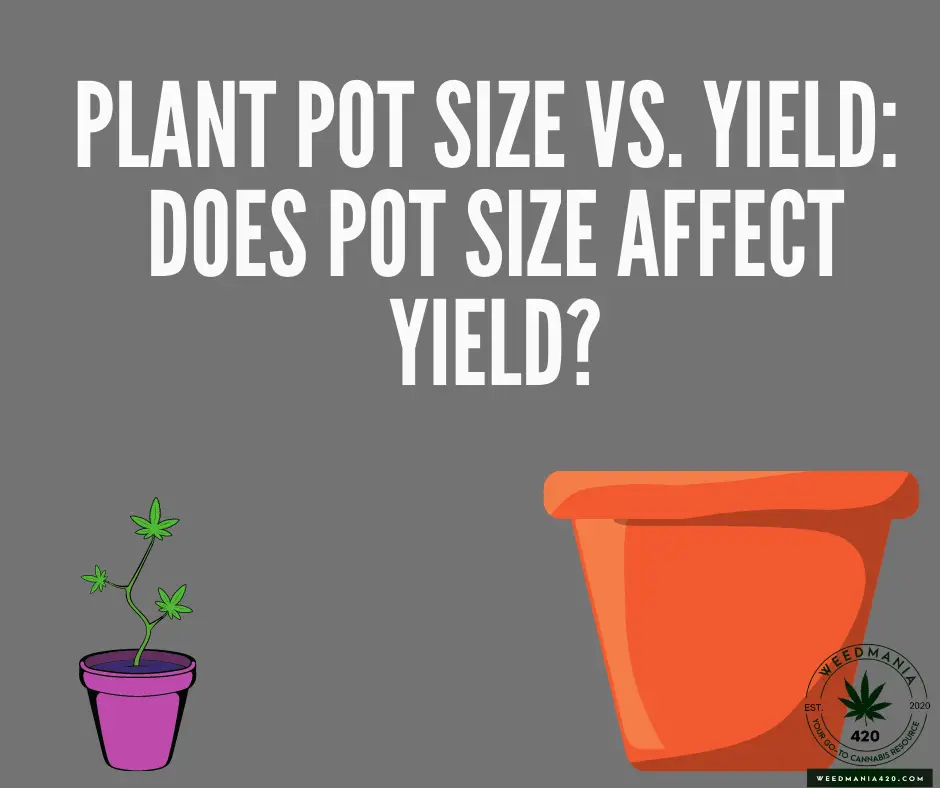The plant pot size affects yield because it controls how big the plant can grow. The pot is the chalice from where the plant draws all the essential nutrients.
If it’s inadequate, it means your plant is drinking from a half-empty glass. Thus, not getting enough nutrients to sustain the changes through the growth phases.
One of the problems I encountered as a beginner grower is deciding the pot size for my weed plants. I began with an autoflowering strain mostly because I wanted it fast, and eight weeks was enough to either reap the benefits or learn the lessons.
I learned my lessons. The pot I used was small—a 1-gallon paint bucket wasn’t enough, and though I figured it out late into the process, I didn’t want to change pots given the short maturity of most autos.
There wasn’t much of a yield— 2 oz only!
Being my first time, I guess many things might have gone wrong, but I think the pot size was the major throw-off in my first grow.
When dealing with autos, you need to be careful with the pot sizes you choose from the beginning because they don’t give you room to change the pots later.
After my failed attempt at growing in 1-gallon paint buckets, I now start my autos on 3-gallon pots. And I’ve gotten nearly three times what I got with the 1-gallon pot.
The best yield so far was 8 oz—still, the same strain.Though I have advanced in high-yielding training techniques, I did nothing much after the first topping. And so much of this change in yield must have been the result of using bigger pots.
Does Pot Size Affect Yield?
Pot size affects yields considerably. The roots need enough space to develop and absorb all the nutrients optimally. The healthier the root system, the faster the plant grows, the bigger it gets, the more bud sites, and bigger buds. However, many factors affect yield, and growing in a bigger pot doesn’t always mean a bigger yield.
Increasing the pot size works when the plant actually needs the space to spread the roots. (Which in most cases, they do).
There is a reason why growers report plants after various stages. For instance, most people begin in 2-gallon pots and move to 5-gallon pots after veg.
This helps a lot because as the plant grows bigger, it needs more nutrients. Thus, rely on robust roots to deliver the nutes from the medium efficiently.

The pot will take in more water for the roots to absorb, and it allows you to pace watering sessions favorably.
When the pot is big enough, you will water less frequently because the moisture lasts longer in the medium. The larger pots also allow you to tether the plant’s branches far and wide to the sides, spreading them for better light exposure.
Big pots allow your plants to grow bigger, and bigger plants yield more than small plants. Bigger plants have more bud sites and have a stronger system to support fat buds, thus a bigger yield.
Plant Pot Size Vs. Yield: Factors You Should Consider
Increasing the plant pot size alone might not help you. Improving cannabis yield takes a little more effort at tweaking key growth factors.
Change the pot’s size if it’s limiting, but also adjust the following:
Lighting
Lighting is king when you want to get the best out of your cannabis plants.
And when you make the plant pots bigger, all the more reasons to improve your grow lights.
A bigger pot means the plant will grow bigger, and as it grows taller, the top branches will block light.
The lower bud sites won’t get as much light as they ought to. So if you don’t improve the intensity of the lights, you might end up losing those lower buds.
If you’re using 400W light in a 2-gallon, switch to 1000W when you repot the plants to a 5-gallon pot.
The plants need the extra intensity to penetrate to the lower bud sites.
The strong lights are necessary because the roots are absorbing more water and nutes.
Stronger lights improve the rate of photosynthesis to utilize the extra nutrients the plants are taking in.
Veg Time
When you increase the plant’s pot, also consider the veg time.
Increasing the pot size without increasing veg duration wastes your efforts. Instead, give the plant more time to grow enough branches for more bud sites and better yield.
If you flower too soon, the nutrients will be sufficient, but the plant’s roots won’t be long enough to reach all of them.
Letting the plant grow bigger allows it to take in and use all the more nutes for bigger buds and better yield.
Extend the veg time by two weeks to take full advantage of the extra pot size.
Tent size
Outside, you can keep your pots as big as you’d like and veg for the longest time.
But when you grow inside a tent, your plant’s height will be limited.
Most tents are only 2 meters in height, and you need to leave an 18” between the canopy and the lights.
Consider how big you want the plants to be, and then use an appropriate tent.
You can also lower the number of plants in the tent to give more room for the extended veg time.
For some strains, increasing veg time means you have to supercrop the plants to control their height.
Watering
When you move to a larger pot, some things change about how you water.
The pot will require more water per session, but you will water less frequently.
If you maintain your watering schedules, you risk overwatering the plant because the medium holds water for longer.
I always increase the fans just so the air circulates better. With bigger pots being damp for long, you risk mold and other bugs if your ventilation is poor.
Grow Medium
If you grow in coco, you can use smaller pots without getting rootbound. Coco is much more inert and has better nutrient absorption even when the roots are crowded.
On the other hand, soil mediums do better when the pots are big. If you grow in soil, repotting to a much bigger pot for flowering makes sense.
Thus, for coco, you can grow in small pots and still get maximum yield.

Can You Grow Cannabis In 2 Gallon Pots?
The 2-galon pots are the best to flower in when using coco. They are spacious enough for the plants to grow and thrive. You can also use them for soil mediums successfully, but bigger strains might force you to repot into larger pots. Some strains grow way too big.
Using bigger pots for coco comes with the risk of poor aeration.
Go for coarse, chunky coco when you intend to use bigger pots or add chunky perlite to improve air circulation to the roots.
I don’t like fine coco as they tend to hold firmly together, forming a ‘slab’ that inhibits air circulation.
For bigger pots, it gets worse. You might have to use a knife to open it up. Such an air-starved root environment is more susceptible to root fungi.
The problem you’re avoiding isn’t only stunted plants, but you risk root problems if they are crowded in small pots.
In conclusion, pot sizes affect your yield to a degree. This is because the plants need enough room for roots to absorb sufficient nutrients.
However, when the pots are too big, especially for coco, you risk root problems because fine coco gets caked, making it tough for air to reach the roots.
Changing pot sizes alone without adjusting the grow essentials to cater to the extra plant’s need might not yield much.
Improve lighting, increase veg time, and supplement the feed as necessary. The extra veg time adds more bud weight and numbers, improving your yield.
Over the years, I’ve learned that any high-yielding technique that entails vegging longer always requires adjusting key growth factors.
Light, feeds, or watering schedules, must all be in sync for maximum yield.

